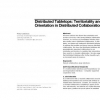Free Online Productivity Tools
i2Speak
i2Symbol
i2OCR
iTex2Img
iWeb2Print
iWeb2Shot
i2Type
iPdf2Split
iPdf2Merge
i2Bopomofo
i2Arabic
i2Style
i2Image
i2PDF
iLatex2Rtf
Sci2ools
CHI
2007
ACM
2007
ACM
Distributed tabletops: territoriality and orientation in distributed collaboration
Previous research has shown that orientation and territory serve key roles during tabletop collaboration. However, no one has yet investigated whether they can play similar roles in distributed collaboration. In this paper, we design and implement distributed tabletops to address this problem and hence improve distributed collaboration. We show that distributed tabletops allow geographically-separated collaborators to use orientation and territory to mediate their interactions as they would in co-located collaboration. We also suggest that distributed tabletops offer further benefits such as an increased sense of presence. Keywords Remote collaboration, large interfaces ACM Classification Keywords H.5.3 [Information Interfaces and Presentation]: Group and Organization Interfaces ? Computer-supported cooperative work.
CHI 2007 | Co-located Collaboration | Human Computer Interaction | Keywords Remote Collaboration | Tabletop Collaboration |
| Added | 30 Nov 2009 |
| Updated | 30 Nov 2009 |
| Type | Conference |
| Year | 2007 |
| Where | CHI |
| Authors | Philip Tuddenham |
Comments (0)

